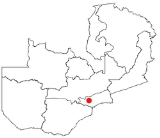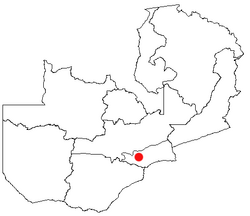
Lusaka Ceasefire Agreement
Encyclopedia

Second Congo War
The Second Congo War, also known as Coltan War and the Great War of Africa, began in August 1998 in the Democratic Republic of the Congo , and officially ended in July 2003 when the Transitional Government of the Democratic Republic of the Congo took power; however, hostilities continue to this...
through a ceasefire
Ceasefire
A ceasefire is a temporary stoppage of a war in which each side agrees with the other to suspend aggressive actions. Ceasefires may be declared as part of a formal treaty, but they have also been called as part of an informal understanding between opposing forces...
, release of prisoners of war, and the deployment of an international peacekeeping force under the auspices of the United Nations
United Nations
The United Nations is an international organization whose stated aims are facilitating cooperation in international law, international security, economic development, social progress, human rights, and achievement of world peace...
. The heads of state of Angola
Angola
Angola, officially the Republic of Angola , is a country in south-central Africa bordered by Namibia on the south, the Democratic Republic of the Congo on the north, and Zambia on the east; its west coast is on the Atlantic Ocean with Luanda as its capital city...
, the Democratic Republic of the Congo
Democratic Republic of the Congo
The Democratic Republic of the Congo is a state located in Central Africa. It is the second largest country in Africa by area and the eleventh largest in the world...
, Namibia
Namibia
Namibia, officially the Republic of Namibia , is a country in southern Africa whose western border is the Atlantic Ocean. It shares land borders with Angola and Zambia to the north, Botswana to the east and South Africa to the south and east. It gained independence from South Africa on 21 March...
, Rwanda
Rwanda
Rwanda or , officially the Republic of Rwanda , is a country in central and eastern Africa with a population of approximately 11.4 million . Rwanda is located a few degrees south of the Equator, and is bordered by Uganda, Tanzania, Burundi and the Democratic Republic of the Congo...
, Uganda
Uganda
Uganda , officially the Republic of Uganda, is a landlocked country in East Africa. Uganda is also known as the "Pearl of Africa". It is bordered on the east by Kenya, on the north by South Sudan, on the west by the Democratic Republic of the Congo, on the southwest by Rwanda, and on the south by...
, Zambia
Zambia
Zambia , officially the Republic of Zambia, is a landlocked country in Southern Africa. The neighbouring countries are the Democratic Republic of the Congo to the north, Tanzania to the north-east, Malawi to the east, Mozambique, Zimbabwe, Botswana and Namibia to the south, and Angola to the west....
, and Zimbabwe
Zimbabwe
Zimbabwe is a landlocked country located in the southern part of the African continent, between the Zambezi and Limpopo rivers. It is bordered by South Africa to the south, Botswana to the southwest, Zambia and a tip of Namibia to the northwest and Mozambique to the east. Zimbabwe has three...
signed the agreement in Lusaka
Lusaka
Lusaka is the capital and largest city of Zambia. It is located in the southern part of the central plateau, at an elevation of about 1,300 metres . It has a population of about 1.7 million . It is a commercial centre as well as the centre of government, and the four main highways of Zambia head...
, Zambia on July 10, 1999.
Negotiation
Representatives from the Southern African Development CommunitySouthern African Development Community
The Southern African Development Community is an inter-governmental organization headquartered in Gaborone, Botswana. Its goal is to further socio-economic cooperation and integration as well as political and security cooperation among 15 southern African states...
, Organization of African Unity, and the United Nations
United Nations
The United Nations is an international organization whose stated aims are facilitating cooperation in international law, international security, economic development, social progress, human rights, and achievement of world peace...
met in Lusaka and drafted the ceasefire agreement from June 21-27 , 1999. Defense and Foreign Ministers of the parties to the conflict then met from June 29 to July 7 to discuss the agreement.
Zambian President Frederick Chiluba
Frederick Chiluba
Frederick Jacob Titus Chiluba was a Zambian politician who was the second President of Zambia from 1991 to 2002. Chiluba, a trade union leader, won the country's multi-party presidential election in 1991 as the candidate of the Movement for Multiparty Democracy , defeating long-time President...
played a major role in the signing of the agreement in his role as Chairman of the Regional Initiative for Peace in the Democratic Republic of the Congo.
Treaty terms
The parties agreed to halt all military operations within 24 hours of signing the agreement in Article I, clause 2, section c. Article I prohibited further military movement or the transfer of armaments to the battlefieldBattle
Generally, a battle is a conceptual component in the hierarchy of combat in warfare between two or more armed forces, or combatants. In a battle, each combatant will seek to defeat the others, with defeat determined by the conditions of a military campaign...
and called on all nations to respect human rights
Human rights
Human rights are "commonly understood as inalienable fundamental rights to which a person is inherently entitled simply because she or he is a human being." Human rights are thus conceived as universal and egalitarian . These rights may exist as natural rights or as legal rights, in both national...
and protect civilians. Article III released all prisoners of war in clause 8 and gave the International Red Cross the task of assisting the wounded in clause 9. Clause 11 requested the deployment of a United Nations peacekeeping
Peacekeeping
Peacekeeping is an activity that aims to create the conditions for lasting peace. It is distinguished from both peacebuilding and peacemaking....
force in accordance with Chapter VII of the United Nations Charter
Chapter VII of the United Nations Charter
Chapter VII of the United Nations Charter sets out the UN Security Council's powers to maintain peace. It allows the Council to "determine the existence of any threat to the peace, breach of the peace, or act of aggression" and to take military and nonmilitary action to "restore international peace...
. The document also requested that the OAU establish a temporary peacekeeping force to combat militant groups until the UN force arrived. Mwesiga Laurent Baregu and Chris Landsberg of the International Peace Academy criticized this provision in 2003, saying the OAU had been overwhelmed and the SADC was better equipped to handle the burden.
Implementation
The United Nations Secretary General issued a report recommending the deployment of an observer mission in the DRC on July 15, 1999. The United States State Department announced its support for a peace mission on July 23. The MLC signed the agreement on August 1. Five days later the United Nations Security CouncilUnited Nations Security Council
The United Nations Security Council is one of the principal organs of the United Nations and is charged with the maintenance of international peace and security. Its powers, outlined in the United Nations Charter, include the establishment of peacekeeping operations, the establishment of...
passed Resolution 1258
United Nations Security Council Resolution 1258
United Nations Security Council Resolution 1258, adopted unanimously on August 6, 1999, after reaffirming Resolution 1234 on situation in the Democratic Republic of the Congo, the Council authorised the deployment of military liaison personnel to the capitals of the signatories of the Lusaka...
deploying military liaison personnel to the capitals of the signatories of the Ceasefire Agreement and established a Joint Military Commission to oversee its implementation. The Rally for Congolese Democracy
Rally for Congolese Democracy
The Congolese Rally for Democracy, sometimes Rally for Congolese Democracy, was a rebel group operating in the eastern region of the Democratic Republic of the Congo . Assisted by the government of Rwanda, it was a major factor in the Second Congo War . It became a political party in 2003...
(RCD) rebel group signed the agreement on August 31. The Security Council established the United Nations Mission in the Democratic Republic of Congo
United Nations Mission in the Democratic Republic of Congo
The United Nations Organization Stabilization Mission in the Democratic Republic of the Congo or MONUSCO , is a United Nations peacekeeping force in the Democratic Republic of the Congo which was established by the United Nations Security Council in resolutions 1279...
(MONUC) in Resolution 1273
United Nations Security Council Resolution 1273
United Nations Security Council Resolution 1273, adopted unanimously on November 5, 1999, after reaffirming resolutions 1234 and 1258 on situation in the Democratic Republic of the Congo, the Council extended the deployment of the 90 military liaison personnel as part of efforts to assist the...
, passed on November 5, to January 15, 2000. Resolution 1279
United Nations Security Council Resolution 1279
United Nations Security Council Resolution 1279, adopted unanimously on November 30, 1999, after recalling resolutions 1234 , 1258 and 1273 on situation in the Democratic Republic of the Congo, the Council established the United Nations Mission in the Democratic Republic of Congo for an initial...
, passed on November 30, extended the mandate to March 1, 2000.

